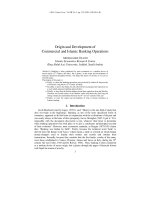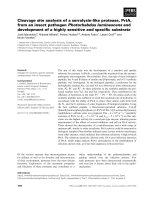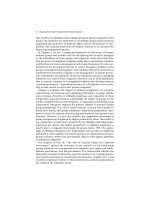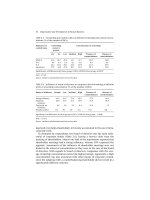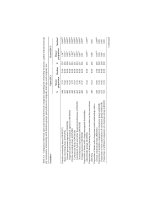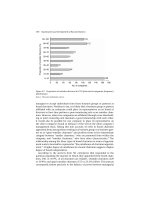Opal''''s Site Organization and Development of Russian Business_1 docx
Bạn đang xem bản rút gọn của tài liệu. Xem và tải ngay bản đầy đủ của tài liệu tại đây (206.83 KB, 23 trang )
Organization and Development of Russian Business
9780230_217287_01_ e . dd 5/20/2009 4:56:26 PM
This page intentionally left blank
Organization and
Development of Russian
Business
A Firm-Level Analysis
Edited by
Tatiana Dolgopyatova, Ichiro Iwasaki,
and Andrei A. Yakovlev
9780230_217287_01_ e . dd 5/20/2009 4:56:27 PM
Selection and Editorial matter © Tatiana Dolgopyatova, Ichiro Iwasaki and
Andrei A. Yakovlev 2009
Individual chapters © Contributors 2009
All rights reserved. No reproduction, copy or transmission of this
publication may be made without written permission.
No portion of this publication may be reproduced, copied or transmitted
save with written permission or in accordance with the provisions of the
Copyright, Designs and Patents Act 1988, or under the terms of any licence
permitting limited copying issued by the Copyright Licensing Agency,
Saffron House, 6-10 Kirby Street, London EC1N 8TS.
Any person who does any unauthorized act in relation to this publication
may be liable to criminal prosecution and civil claims for damages.
The authors have asserted their rights to be identified as the authors of this work
in accordance with the Copyright, Designs and Patents Act 1988.
First published 2009 by
PALGRAVE MACMILLAN
Palgrave Macmillan in the UK is an imprint of Macmillan Publishers Limited,
registered in England, company number 785998, of Houndmills, Basingstoke,
Hampshire RG21 6XS.
Palgrave Macmillan in the US is a division of St Martin’s Press LLC,
175 Fifth Avenue, New York, NY 10010.
Palgrave Macmillan is the global academic imprint of the above companies
and has companies and representatives throughout the world.
Palgrave® and Macmillan® are registered trademarks in the United States,
the United Kingdom, Europe and other countries.
ISBN-13: 978–0–230–21728–7 hardback
ISBN-10: 0–230–21728–1 hardback
This book is printed on paper suitable for recycling and made from fully
managed and sustained forest sources. Logging, pulping and manufacturing
processes are expected to conform to the environmental regulations of the
country of origin.
A catalogue record for this book is available from the British Library.
Library of Congress Cataloging-in-Publication Data
Organization and development of Russian business : a firm-level analysis /
edited by Tatiana Dolgopyatova, Ichiro Iwasaki, and Andrei A. Yakovlev.
p. cm.
Includes bibliographical references and index.
ISBN 978–0–230–21728–7 (alk. paper)
1. Corporate governance – Russia (Federation) I. Dolgopyatova, Tatiana,
1951– II. Iwasaki, Ichiro. III. Yakovlev, Andrei A.
HD2741.O74 2009
338.60947—dc22 2009013790
10 9 8 7 6 5 4 3 2 1
18 17 16 15 14 13 12 11 10 09
Printed and bound in Great Britain by
CPI Antony Rowe, Chippenham and Eastbourne
9780230_217287_01_ e . dd 5/20/2009 4:56:27 PM
v
Contents
List of Tables vii
List of Figures xi
Acknowledgments xii
Notes on the Contributors xiii
List of Abbreviations xiv
Introduction 1
Tatiana G. Dolgopyatova, Ichiro Iwasaki, and Andrei A. Yakovlev
1 The Emergence of Russian Corporations: From
the Soviet Enterprise to a Market Firm 12
Tatiana G. Dolgopyatova, Ichiro Iwasaki, and Andrei A. Yakovlev
Part I Ownership, Internal Control, and
Management System
2 Stock Ownership and Corporate Control 39
Tatiana G. Dolgopyatova
3 Legal Form of Incorporation 62
Ichiro Iwasaki
4 The Structure of Corporate Boards 89
Ichiro Iwasaki
5 Impact of Corporate Governance and Performance on
Managerial Turnover 122
Naohito Abe, and Ichiro Iwasaki
6 Management Team and Firm Restructuring 148
Victoria V. Golikova
Part II Business Integration and Its Impacts on
Corporate Governance
7 Organizational Patterns of Corporate Control and
Business Integration 173
Tatiana G. Dolgopyatova
8 Corporate Governance and Decision-Making in Business Groups 195
Svetlana B. Avdasheva
9780230_217287_01_ e . dd 5/20/2009 4:56:28 PM
vi Contents
9 Impact of Business Integration on Corporate
Restructuring and Performance 213
Svetlana B. Avdasheva
Part III The Role of External Agents in
Corporate Governance
10 The Banking Sector and Corporate Finance 235
Fumikazu Sugiura
11 Business Associations: Incentives and Benefits from
the Viewpoint of Corporate Governance 258
Victoria V. Golikova
12 State–Business Relations and Improvement of
Corporate Governance 284
Andrei A. Yakovlev
Conclusions 307
Tatiana G. Dolgopyatova, Ichiro Iwasaki, and Andrei A. Yakovlev
Appendix: Outline of the Japan–Russia Joint Enterprise Survey 312
Tatiana G. Dolgopyatova, and Ichiro Iwasaki
Index 321
9780230_217287_01_ e . dd 5/20/2009 4:56:28 PM
vii
Tables
I.1 Selected macroeconomic indicators of the Russian
transition economy, 1992–2007 2
1.1 Chronology of enterprise reforms and related events in
the USSR and Russia, 1986–2007 17
1.2 Privatization of state-owned enterprises and
privatization revenue in Russia, 1993–2007 23
2.1 Intra-corporate disputes in 2001–2004 at different levels of
ownership concentration 44
2.2 Average percentage of ordinary shares owned by type of
shareholder at different levels of ownership concentration 45
2.3 Current economic situation of enterprises at different levels of
ownership concentration 49
2.4 Coefficients for the variable “concentration of ownership” in
regression models 51
2.5 Ownership and control in JSCs at different ownership and
control concentrations 54
2.6 Influence of board of directors on corporate decision-making at
different levels of ownership concentration 54
2.7 Structure of board of directors at different levels of capital
concentration 56
3.1 Differences in the legal framework between open and
closed joint-stock companies in Russia 66
3.2 Comparative advantages of open and closed companies
over an alternative corporate form of joint-stock company 70
3.3 Most important reason for being in the current corporate form 71
3.4 Comparison between open and closed joint-stock companies
regarding the ownership structure, capital demand and supply
constraints, relationship with business groups, past policies on
company start-ups, and company size 77
3.5 Probit regression analysis of the corporate-form choice model 80
4.1 Descriptive statistics on board size and number of
directors by their attributes of 730 surveyed firms 95
4.2 International comparison of board size and
proportion of outsider directors 96
4.3 Correlation matrix of board components 101
4.4 Theoretical predictions of the impacts of firm
organization and business activities on board components 107
9780230_217287_01_ e . dd 5/20/2009 4:56:28 PM
viii Tables
4.5 Definition, descriptive statistics, and data source of
variables used in the empirical analyses and correlation
coefficients with board components 110
4.6 2SLS system estimates of endogenous board formation 112
5.1 Studies of managerial turnover in Russian firms 126
5.2 Results from vote-counting analysis of the impact of
different types of owners and changes in ownership
structure on CEO turnover 128
5.3 Descriptive statistics of independent variables by
company group in terms of turnover type 134
5.4 Logit regression analysis of the impacts of corporate
governance and performance on CEO turnover 136
5.5 Multinomial probit regression analysis of the impacts of
corporate governance and performance on managerial
turnover taking its magnitude into consideration 138
5.6 Multinomial probit regression analysis of the impacts of
corporate governance, corporate performance, and
internal conflict on managerial turnover taking its
magnitude into consideration 141
6.1 Recruiting sources of general directors at independent
enterprises and in HCGs 152
6.2 Characteristics of managerial skills and experience by
different status of company location 153
6.3 Change of general director/board chairman at independent
enterprises and HCGs depending on changes of
main company shareholders in 2001–2004 155
6.4 Change of middle-level managers in JSCs in which the general
director was changed by the status of the current director 157
6.5 Logistic regression analysis of the propensity of
proactive restructuring 162
7.1 Ownership and management configuration at affiliated
companies of holding company groups 176
7.2 Characteristics of intra-corporate control 178
7.3 Turnover of CEOs, boards of directors, and
its chairs in 2001–2004 179
7.4 Comparison of JSCs with separation or combination of
ownership and management 184
7.5 Logistic regressions for shareholder choice of separated
ownership and management 186
7.6 Logistic regressions for shareholder choice of separated
ownership and management and corporate integration 189
8.1 Enterprises coordinating strategic decisions with
outside stakeholders 203
9780230_217287_01_ e . dd 5/20/2009 4:56:28 PM
Tables ix
8.2 Ownership and management in JSCs depending on
their affiliation with BGs 204
8.3 Boards of directors in subsidiaries of BGs in regulated and
nonregulated industries 207
9.1 Impact of membership in business groups on
restructuring activity 221
9.2 Impact of membership in business groups on
performance indicators 224
9.3 Total factor productivity in subsidiaries of BGs compared with
independent enterprises (Cobb–Douglas production
function, output in 2004) 226
10.1 Financing sources of fixed investment 237
10.2 Recent Sberbank financial undertakings 240
10.3 Asset structure of Sberbank 244
10.4 Definitions, descriptive statistics, and sources of
variables used in the empirical analysis 249
10.5 Results of regression analysis on enterprises with no
external borrowings 250
10.6 Certain characteristics of enterprises depending on main
source(s) of external finance 251
10.7 Results of regression analysis on enterprises with
borrowings from Sberbank 253
11.1 Characteristics of companies: Members and
nonmembers of business associations 263
11.2 Indicators of financial standing of joint-stock companies and
membership in business associations 264
11.3 Types of support rendered to authorities and aid
through various channels depending on membership in
business associations 265
11.4 Benefits for members of associations from
the establishment of steady contacts with authorities 266
11.5 Logistic regression analysis of the determinants of
participation in business associations 270
11.6 Logistic regression analysis of probability to obtain
financial and organizational support from the state authorities 274
11.7 Utility of business associations and their contribution to
the establishment of standards and rules of conduct of
business, evaluated by respondents in 2002 and 2005 276
11.8 Evaluation of contribution of NGBOs to the solution of
important problems of the business community by
the respondent joint stock companies 277
12.1 Construction of the CG_IDX 290
12.2 Distribution of firms depending on the value of the CG_IDX 290
9780230_217287_01_ e . dd 5/20/2009 4:56:28 PM
x Tables
12.3 State-controlled companies and firms with a minority stake
held by the government 291
12.4 Construction of the POLCON variable 292
12.5 Distribution of firms depending on the value of
the POLCON variable 292
12.6 Correlation matrix of the variables used in
the regression analysis 293
12.7 Definitions and descriptive statistics of control variables 294
12.8 Ordinary probit regression analysis of the effect of
state ownership on the quality of corporate governance 297
12.9 Ordinary probit regression analysis of the effect of political
connections on the quality of corporate governance 300
A.1 Composition of respondents by their position in a company 314
A.2 Geographical composition of the surveyed firms:
Comparison with offical statistics 315
A.3 Sectoral composition of industrial firms surveyed:
Comparison with offical statistics 316
A.4 Composition of the surveyed firms by
total number of employees 316
A.5 Breakdown of the surveyed firms by location,
sector and industry, form of incorporation, and
total number of employees 318
9780230_217287_01_ e . dd 5/20/2009 4:56:28 PM
xi
Figures
I.1 Foreign direct investment inflow into Russia, 1995–2007 4
2.1 Classification of surveyed joint-stock companies by level of
ownership concentration 42
2.2 Concentration of ownership in independent and
integrated companies 43
2.3 Modernization activities of companies at different levels of
ownership concentration 48
2.4 Classification of surveyed companies by participation of
shareholders in their management 53
4.1 Board size of 730 joint-stock companies 98
4.2 Proportion of outsider directors for 730 joint-stock companies 100
5.1 Changes in CEO turnover frequency, 1993–2003 124
5.2 Changes in average ownership share by insiders, outside
shareholders, and the state in industrial firms, 1994–2002 125
6.1 Change of managers in the departments following a new
general director appointment by shareholders’ decision 157
7.1 Links between ownership and management in integrated and
independent companies 175
8.1 Share of business groups (BGs) in number of companies and
in employment 198
8.2 Instruments to solve the agency problem in
Russian BG subsidiaries 210
9.1 Gains from joining business groups (BGs) according to
directors of enterprises by time of merger 217
9.2 Restructuring activity in subsidiaries of BG vis-à-vis
independent companies 218
9.3 Financial performance of different types of enterprises 223
10.1 Trend of major asset and liability items of Russian enterprises 238
10.2 Composition of bank credits in Russia 242
10.3 Existence of a main bank relationship 245
10.4 Maturity structure (the longest) of borrowings made
during 2001–2004 246
10.5 External funds raised in 2004 and banks that offered the most 246
11.1 Membership in associations by type of settlement 268
11.2 Strategies of membership in associations 272
A.1 Composition of the surveyed firms by sector and industry 315
9780230_217287_01_ e . dd 5/20/2009 4:56:28 PM
xii
Acknowledgments
This volume presents one of the results from the Japan–Russia joint research
project entitled “Corporate Governance and Integration Processes in the
Russian Economy” conducted by staff members of the Institute of Economic
Research of Hitotsubashi University, the Institute for Industrial and Market
Studies of Higher School of Economics, and Teikyo University. These insti-
tutions provided considerable support with the organization of the study
meetings and conference presentations within the framework of the project.
As reported in the chapters, the authors received financial support from sev-
eral research funds and state institutions, including those from the Inamori
Foundation, the Japan Securities Scholarship Foundation, the Ministry of
Education and Science of Japan, the Moscow Science Public Foundation
sponsored by the USAID, the Program for Fundamental Studies of Higher
School of Economics supported by the Ministry of Economic Development
and Trade of the Russian Federation, and the Zengin Foundation for Studies
on Economics and Finance. We also acknowledge the sponsorship from
the Foundation of the Japan Legislation Society and the Russian Research
Center of the Institute of Economic Research at Hitotsubashi University to
carry out editorial work and English proofreading of the whole book.
The editors thank all the contributors to this volume for their serious
efforts and insights. The editors are also grateful to Yuka Miura and Asahi
Nishihara for their administration of the project and to Akira Ishida, Elena
Leont’eva, and Jim Treadway for their assistance with the preparation of the
manuscripts. The authors appreciate their colleagues and the participants of
the aforesaid study meetings and conferences for their valuable comments
and suggestions on their research works published in this volume.
Last but not least, all the authors would like to extend their thanks to
Taiba Batool, Alec Dubber, and Gemma Papageorgiou of the editorial staff of
Palgrave Macmillan, as well as Vidhya Jayaprakash and the team at Newgen
Imaging Systems for their kind cooperation.
9780230_217287_01_ e . dd 5/20/2009 4:56:28 PM
xiii
Contributors
Naohito Abe is Associate Professor at the Institute of Economic Research at
Hitotsubashi University, Tokyo.
Svetlana B. Avdasheva is Professor of the Faculty of Economics and
Deputy Director of the Institute for Industrial and Market Studies at State
University – Higher School of Economics, Moscow.
Tatiana G. Dolgopyatova is Chief Researcher at the Institute for Industrial
and Market Studies and Professor of the Faculty of Economics at State
University – Higher School of Economics, Moscow.
Victoria V. Golikova is Senior Research Fellow at the Institute for Industrial
and Market Studies at State University – Higher School of Economics,
Moscow.
Ichiro Iwasaki is Professor at the Institute of Economic Research at
Hitotsubashi University, Tokyo.
Fumikazu Sugiura is Assistant Professor of the Faculty of Economics at
Teikyo University, Tokyo.
Andrei A. Yakovlev is Director of the Institute for Industrial and Market
Studies and Vice-Rector at State University – Higher School of Economics,
Moscow.
9780230_217287_01_ e . dd 5/20/2009 4:56:29 PM
xiv
Abbreviations
ANOVA analysis of variance
BA business association
BEEPS Business Environment and Enterprise Performance Survey
BG business group
CEO chief executive officer
CG corporate governance
CIS Commonwealth of Independent States
EACES European Association for Comparative Economic Studies
EBRD European Bank for Reconstruction and Development
FCSM Federal Commission for Securities Market of Russia
FDI foreign direct investment
FFMS Federal Financial Markets Service of Russia
FGUP corporatization of federal state enterprises
FIG financial-industrial group
FSU former Soviet Union
GAAP Generally Accepted Accounting Principles
GDP gross domestic product
HCG holding company group
IAS International Accounting Standards
IBRD International Bank for Reconstruction and Development
IER Institute of Economic Research, Hitotsubashi University
IIA independence from irrelevant alternatives
IMF International Monetary Fund
IPO initial public offering
JACES Japanese Association for Comparative Economic Studies
JSC joint-stock company
LSE London Stock Exchange
M&A mergers and acquisitions
MBA master of business administration
MIC military-industrial complex
MNL multinomial logit estimator
MNP multinomial probit estimator
NASDAQ National Association of Securities Dealers Automated
Quotations
NCCG National Council on Corporate Governance
NYSE New York Stock Exchange
OECD Organization for Economic Cooperation and Development
9780230_217287_01_ e . dd 5/20/2009 4:56:29 PM
Abbreviations xv
OKONKH Russian All-Union Classifier of the National Economy
Branches
OLS ordinary least squares
R&D research and development
REB Russian Economic Barometer
RF Russian Federation
ROA return on assets
ROSSTAT Federal State Statistical Service of Russia
RSFSR Russian Soviet Federative Socialist Republic
RTS Russian Trading System Stock Exchange
S&P Standard & Poor’s
SBERBANK Savings Bank of Russia
SOE state-owned enterprise
SME small and medium-sized enterprise
SU-HSE State University-Higher School of Economics
TACIS Technical Aid to the Commonwealth of Independent States
Program
TFP total factor productivity
TTPP Think Tanks Partnership Program
UES Unified Energy System of Russia
USAID United States Agency for International Development
USSR Union of Soviet Socialist Republics
VTB Bank for Foreign Trade of Russia
9780230_217287_01_ e . dd 5/20/2009 4:56:29 PM
This page intentionally left blank
1
Introduction
Tatiana G. Dolgopyatova, Ichiro Iwasaki, and Andrei A. Yakovlev
This book was published 17 years after the collapse of the Soviet Union in
December, 1991. The transitional path to a market-oriented economy in the
Russian Federation, where socialism had been developing for decades, clearly
shows that the overall restructuring of a planned economy is a time- and
resource-consuming social process. Due to such difficulties, there is a broad
consensus among scholars that systemic transformation in Russia should
continue into the future to achieve a well-functioning market economy.
Nevertheless, government and citizen reform clearly extricated the coun-
try from a dire predicament. Russia is currently in its eleventh year of eco-
nomic recovery from a severe financial crisis in 1998. Table I.1 shows that
the gross domestic product (GDP) has averaged 7% annual growth from
1999 through 2007. The other macroeconomic indicators also suggest great
improvements in the Russian economy. Most economists agree that this
remarkable rise in macroeconomic performance occurred as a result of the
rapid expansion of Russia’s export markets against the historical setting of
increasing energy prices (i.e., oil and natural gas) in the world markets.
It is noteworthy, however, that the long-lasting economic developments
in Russia also depend on the extensive improvement of its corporate sector
as a result of 17 years of structural reforms. Progress is undeniable regard-
ing ownership reform and the management restructuring in Russian enter-
prises in the post-privatization period. Furthermore, Russian investors and
business people are now very actively launching their own companies on
the international stock markets. The expansion of Russian businesses in the
world economy and the considerable growth of foreign direct investment
(FDI) into the Russian real sector have also taken place. In fact, Figure I.1
indicates significant growth of FDI inflow into Russia in 2006 and 2007
in both gross and net terms. Despite a political backlash to market liber-
alization observed in recent years, these facts strongly attest to the inten-
sive integration of Russia into the global markets and the openness of the
Russian domestic markets for multinational enterprises and other foreign
investors.
1
978023_0217287_02_ . dd 1 5/12/2009 5:17:59 PM
Table I.1 Selected macroeconomic indicators of the Russian transition economy, 1992–2007
1992 1993 1994 1995 1996 1997 1998 1999 2000 2001 2002 2003 2004 2005 2006 2007
GDP growth
rate (annual
change in real
term, %)
a
Ϫ14.5 Ϫ8.7 Ϫ12.7 Ϫ4.1 Ϫ3.6 1.4 Ϫ5.3 6.4 10 5.1 4.7 7.3 7.2 6.4 7.4 8.1
GDP per capita
(USD)
a
576 1,237 1,866 2,112 2,642 2,736 1,834 1,328 1,768 2,096 2,379 2,975 4,104 5,326 6,923 9,075
GDP deflator
(2006 = 100)
a
0.1 0.8 3.4 8.3 12.1 14.0 16.6 28.5 39.3 45.8 53.0 60.3 72.5 86.4 100.0 113.5
Consumer
price (end-year,
annual
change, %)
a
1526.0 839.9 215.1 131.3 21.8 11.0 84.4 36.5 20.2 18.6 15.1 12.0 11.7 10.9 9.0 11.9
Industrial gross
output (annual
change in real
term, %)
b
Ϫ16.0 Ϫ14.0 Ϫ21.0 Ϫ4.6 Ϫ8.0 1.0 Ϫ5.0 9.0 8.7 2.9 3.1 8.9 8.0 5.1 6.3 6.3
Agricultural
gross output
(annual change
in real term, %)
b
Ϫ9.4 Ϫ4.0 Ϫ12.0 Ϫ8.0 Ϫ5.0 2.0 Ϫ13.0 4.0 7.7 7.5 1.5 1.3 3.0 2.3 3.6 3.3
Fixed capital
investment
(annual change
in real term, %)
b
Ϫ40 Ϫ12 Ϫ24 Ϫ10 Ϫ18 Ϫ5 Ϫ12 5 17 10 3 13 14 11 17 21
978023_0217287_02_ . dd 2 5/12/2009 5:18:00 PM
Unemployment
rate (end-
year, %)
b
5.2 5.9 8.1 9.5 9.7 11.8 13.2 12.6 9.8 8.8 8.5 7.8 7.9 7.1 6.7 5.6
Current
account
balance (% of
GDP)
a
Ϫ1.4 1.4 2.8 2.2 2.8 0.0 0.1 12.6 18.0 11.1 8.4 8.2 10.1 11.0 9.5 5.9
Trade balance
(Million USD)
10.6 15.3 6.5 20.1 19.8 14.6 16.9 36.2 60.1 48.1 46.3 59.9 85.8 118.4 139.2 132.1
General
government
balance (% of
GDP)
c
Ϫ42.6 Ϫ15.9 Ϫ9.7 Ϫ6.6 Ϫ9.4 Ϫ8.5 Ϫ8.2 Ϫ3.1 3.2 2.7 0.6 1.4 4.9 8.1 8.4 3.7
Private sector
share in
GDP (%)
c
25 40 50 55 60 70 70 70 70 70 70 70 70 65 65 65
Private sector
share in total
employment
(%)
b
19.3 28.1 33.0 34.3 35.6 39.9 43.2 44.3 46.1 47.7 49.6 50.2 51.8 54.1 55.4 56.4
RTS index
(end-of-year)
d
NA NA NA 82.9 200.5 396.9 58.9 175.3 143.3 260.1 359.1 567.3 614.1 1,125.6 1,921.9 2,290.5
Sources:
a
IMF;
b
Rosstat;
c
EBRD;
d
RTS website ( />978023_0217287_02_ . dd 3 5/12/2009 5:18:00 PM
4 Organization and Development of Russian Business
To study the development stage and organization of the contemporary
Russian business sector is essential to assess the potential of the Russian
economy in the global context. This book is designed to make a clear contri-
bution to this issue through its focus on the following key aspects of Russian
firms: (a) the mechanism of monitoring and the decision-making control
given to a highly concentrated ownership structure, which is different from
the case in developed countries; (b) the impacts of business integration via
the formation of holding companies and other types of business groups upon
corporate governance and firm performance of affiliated firms; and (c) the
role and influence of various external agents, such as financial institutions,
business associations, and the state, in the process of corporate governance
of nonfinancial enterprises. We believe that a thorough examination of the
outlined objectives will result in a clear understanding of current Russian
business practices.
To fulfill the research objectives stated above, we mainly utilize the results
of an enterprise survey conducted throughout Russia by a Japan–Russia
joint research team from Hitotsubashi University in Tokyo and the State
University – Higher School of Economics (SU-HSE) in Moscow.
The survey was performed over a five-month period, from February to
June 2005, and 822 members of top management from industrial and
−5,000
0
5,000
10,000
15,000
20,000
25,000
30,000
1995 1996 1997 1998 1999 2000 2001 2002 2003 2004 2005 2006 2007
(Million USD)
Net FDI inflow (EBRD)
Gross FDI inflow (Rosstat)
Figure I.1 Foreign direct investment inflow into Russia, 1995–2007
978023_0217287_02_ . dd 4 5/12/2009 5:18:00 PM
Introduction 5
communications enterprises from 64 regions of the Russian Federation were
interviewed. It was one of the largest-scale questionnaire surveys conducted
in Russia. The sampling and the interviews were conducted by specialists of
the well-known social research organization “Levada-Center” – the former
USSR Public Opinion Poll Center. All samples are joint-stock companies
(JSCs), and the average number of workers in each company is 1,884 (median:
465). The total number of workers of these surveyed firms is 1.55 million,
and they accounted for 10.3% of the average workforce in both the indus-
trial and the communication sectors through 2004, according to official
statistics.
2
In addition, our survey results are reinforced by the commercial Internet
database of the two major company information agencies in Russia, SKRIN,
and SPARK Co., in order to carry out empirical analyses on financial and
operating performance of our sample firms that are compatible with those
in earlier studies of listed companies in developed countries.
Using this unique firm-level dataset as a common empirical basis, we
present multi-angle pictures of the Russian corporate system from the insti-
tutional and microeconomic viewpoints. This is the most clearly distin-
guishing feature of this volume in comparison to prior literature dealing
with firm organizations and corporate governance in the post-communist
transitional countries, including Russia.
In the framework of this joint project, we have also published several jour-
nal articles and books in English, Japanese, and Russian (Avdasheva 2007;
Dolgopyatova 2006, 2007; Iwasaki 2006, 2007, 2008; Dolgopyatova, Iwasaki, &
Yakovlev 2007; Sugiura 2007; Yakovlev 2007). Compiled in this volume are
developed research and new products obtained from the project.
The book consists of 12 chapters and a conclusion.
3
Chapter 1 discusses
how Russian firms developed from Soviet enterprises into market-oriented
firms on the background of large-scale institutional changes in the national
economic system. This chapter also addresses the issue of Russia’s peculiari-
ties in terms of its business environment in comparison to countries at a
similar level of socioeconomic development, such as Central and Eastern
European countries, which passed through a transition from a planned to a
market economy, and the possible impacts of those differences on the enter-
prise behavior in Russia.
The next five chapters in Part I, entitled “Ownership, Internal Control,
and Management System,” provide readers with deep insights into the
organizational architecture of Russian enterprises, including their owner-
ship structure, legal form of incorporation, board of directors, and manage-
rial team. These chapters represent an attempt to examine the empirical
relationship among the internal organizations and enterprise behaviors,
including operating and financial performance.
Chapter 2 examines the linkage between ownership structure and the cor-
porate control system in Russian firms. In this chapter, evidence of simple
978023_0217287_02_ . dd 5 5/12/2009 5:18:00 PM
6 Organization and Development of Russian Business
hypotheses regarding the role of a high concentration of ownership in the
evolution of intra-corporate control forms and business performance is pro-
vided. Our empirical data demonstrates that the largest shareholder owned
more than 50% of the total stock in 70% of the companies and about 13%
of companies had no block-holders (owners of more than 25% of the stock).
The high concentration of ownership is paralleled by its hidden structure
and affects intra-corporate relationships. We also show that some of these
relationships include the development of a set of formal and informal tools
used by dominant shareholders for the supervision of executive manage-
ment in a weak institutional environment. A combination of ownership and
control based on the direct participation of shareholders in management as
top-managers is a characteristic of the vast majority of Russian JSCs; how-
ever, the current trend is for the separation of executive management from
ownership. We argue that concentrated ownership will encourage the own-
ers to restructure and develop their business and companies with dispersed
ownership will thus be less competitive in performance, investment, and
restructuring.
Chapter 3 is a study of the legal form of incorporation of Russian JSCs.
The vast majority of Russian corporations are compelled to become closed
JSCs that lack a modern fundraising mechanism in order to attract capital
from a wide range of private investors. The empirical results in this chapter
suggest the following four factors encouraging many Russian firms to be
closed JSCs. That is (a) a widespread insider-dominating corporate owner-
ship structure emerging as a result of the mass-privatization policy; (b) a
strong orientation among managers toward closed corporate organization
due to the underdeveloped capital and managerial markets; (c) slumping
needs for corporate finance; and (d) insufficient financial support from local
financial institutions. The impact of ownership structure on the choice of
corporate form exists, even if we assume that the two elements are deter-
mined endogenously.
In Chapter 4, we examine the endogenous formation of corporate boards
and its determinants. The findings reported in this chapter strongly suggest
that the theories and empirical methods of financial and organizational
economics help accurately pinpoint the determinants of board size, propor-
tion of outsider directors, and appointment of outside chairmen in Russian
firms. We also found that their board structure can be reasonably explained
by the bargaining hypothesis. Furthermore, the empirical evidence demon-
strated that Russia’s legal system and peculiarities as a transition economy
also have a great deal of influence in determining board formation.
Chapter 5 discusses the possible impacts of corporate governance and
firm performance on managerial turnover. This study is different from most
previous research in that we deal not only with CEO dismissal but also with
managerial turnover in a company as a whole. We found that nonpayment
of dividends is significantly correlated with managerial turnover. We also
978023_0217287_02_ . dd 6 5/12/2009 5:18:00 PM
Introduction 7
found that the presence of dominant shareholders and foreign investors is
another important factor in causing managerial dismissal in Russian corpo-
rations; however, these two kinds of company ownership reveal different
effects in terms of turnover magnitude.
Chapter 6 focuses on the relationship between the structure of a mana-
gerial team and firm restructuring. Following drastic changes in the dis-
tribution and redistribution of property rights in the Russian economy in
the last decade, a new generation of professionally trained managers has
appeared in top- and middle-level management. They are expected to be
great promoters for enterprise restructuring in Russia. At the same time,
many Soviet-generation manager-owners are still in business. These com-
pany executives were often accused of asset-stripping in the 1990s, and they
are considered to be largely responsible for the poor managerial quality due
to the lack of incentives for maximizing a firm’s value. However, no empiri-
cal evidence was available to support or refute this statement. The empirical
analysis in this chapter revealed that neither changes in key owners nor
the appointment of a new general director by shareholder decision con-
tributed to more active firm restructuring. We also verified that firms with
general directors who were large owners did significantly better than those
with hired managers in the introduction of new technologies and market-
ing activities. Furthermore, our empirical evidence indicates that previous
job experience of the CEOs in Western companies contributed positively to
firm restructuring, whereas job experience in governmental bodies tended
to have a negative effect.
The next three chapters in Part II, “Business Integration and Its Impact on
Corporate Governance,” deal with the vertical and horizontal integration
of Russian companies. In Russia, almost 30 to 40% of middle- and large-
scale companies are currently involved in the formation of business groups.
Chapters 7, 8, and 9 present examinations of the impact of this remarkable
phenomenon in the current Russian economy on the organizational behav-
ior and management effectiveness of group companies in comparison with
independent (nongroup) firms.
Chapter 7 deals with the role of business integration in the development
of a form of corporate control based on the separation of executive manage-
ment from ownership. As a result of our empirical investigation into the
determinants of owner selection of hired management, we present the fol-
lowing results. First, business integration promotes the gradual separation of
management from ownership in the rank-and-file membership of company
groups. Second, company affiliation or non-affiliation with a company
group predefines different roles of various factors in this choice. In addi-
tion, for rank-and-file members of company groups, a positive influence
on the choice is connected with the complexity of corporate management
in companies and in entire groups, and a negative influence is related with
an incomplete restructuring of enterprises. Our findings also demonstrate
978023_0217287_02_ . dd 7 5/12/2009 5:18:00 PM

